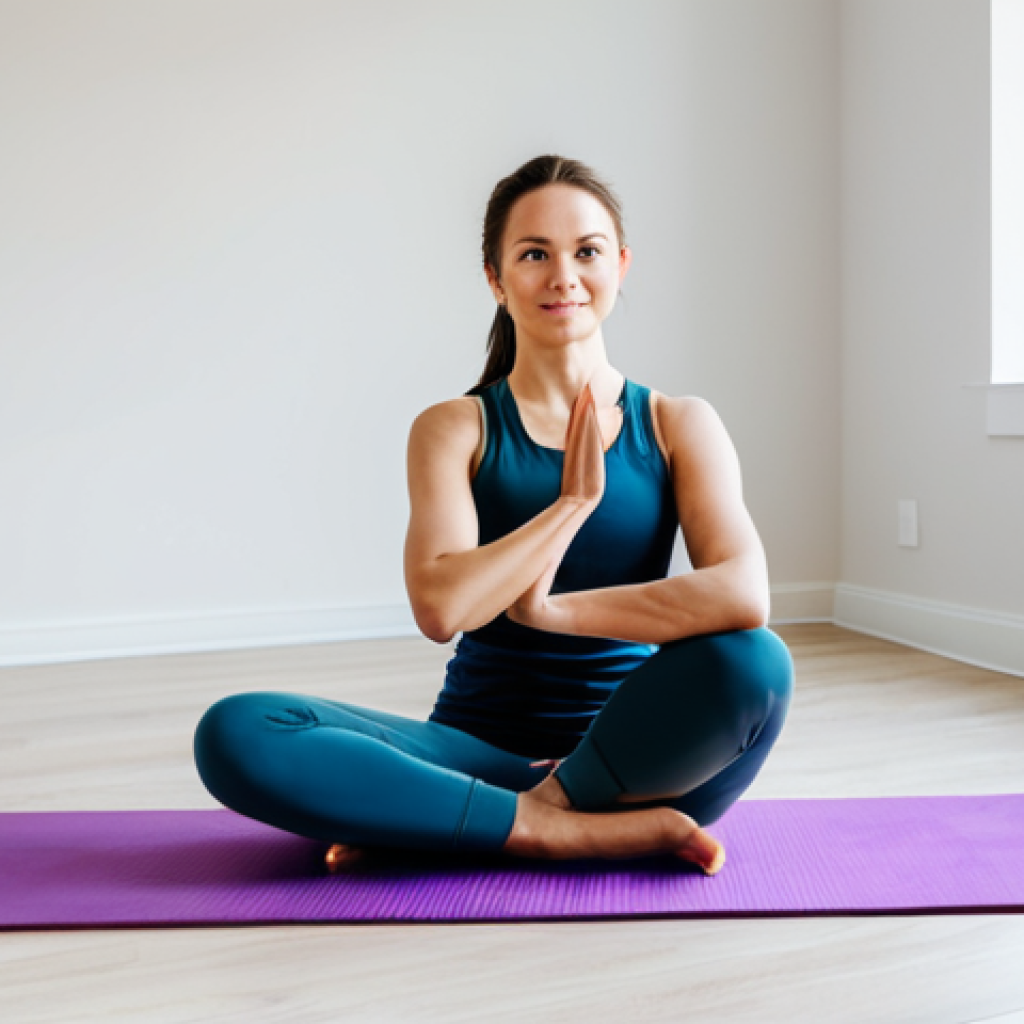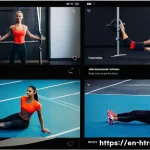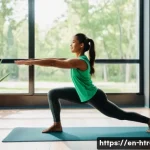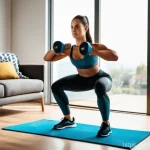After years of battling the daily grind, struggling to fit traditional gym visits into an already overflowing schedule, I realized something critical: true well-being isn’t just about physical exertion.
It’s a delicate dance between sweating it out and nurturing your mind. What I’ve personally found, especially with the boom in online resources and the ongoing shift to remote work, is that home fitness, when paired with intentional mental care practices, becomes an incredibly powerful, accessible duo.
This isn’t just a trend; it’s a profound lifestyle adjustment many of us are making, driven by the desire for holistic health and a more balanced life.
Let’s explore this transformative path together and see how you can benefit. I remember those days vividly, feeling guilty for skipping the gym, then feeling even worse because my mind was racing with to-do lists.
It was a vicious cycle. But when I started experimenting with a 20-minute online yoga class in my living room, followed by a simple five-minute guided meditation, something clicked.
It wasn’t about perfection; it was about consistency and making space for myself. This holistic approach, integrating body and mind, isn’t just a personal revelation; it’s rapidly becoming the norm.
With mental health awareness surging and the digital landscape offering everything from AI-powered fitness coaches to immersive VR meditation apps, the future of wellness is truly in our hands, or rather, our homes.
The pandemic undoubtedly accelerated this shift, forcing us to re-evaluate our routines, and frankly, I don’t see us going back. We’re talking about a paradigm shift where your living room transforms into your personal wellness sanctuary, accessible 24/7, without the exorbitant gym fees or the awkward social pressure.
This isn’t just convenience; it’s empowerment, fostering a deeper connection with your own body and mind, leading to tangible improvements in mood, productivity, and overall life satisfaction.
The global wellness market, particularly in digital health, is projected to soar, indicating a robust future for personalized home-based solutions. I’m convinced this integrated approach is the sustainable answer to modern stress.
After years of battling the daily grind, struggling to fit traditional gym visits into an already overflowing schedule, I realized something critical: true well-being isn’t just about physical exertion. It’s a delicate dance between sweating it out and nurturing your mind. What I’ve personally found, especially with the boom in online resources and the ongoing shift to remote work, is that home fitness, when paired with intentional mental care practices, becomes an incredibly powerful, accessible duo. This isn’t just a trend; it’s a profound lifestyle adjustment many of us are making, driven by the desire for holistic health and a more balanced life. Let’s explore this transformative path together and see how you can benefit.
I remember those days vividly, feeling guilty for skipping the gym, then feeling even worse because my mind was racing with to-do lists. It was a vicious cycle. But when I started experimenting with a 20-minute online yoga class in my living room, followed by a simple five-minute guided meditation, something clicked. It wasn’t about perfection; it was about consistency and making space for myself. This holistic approach, integrating body and mind, isn’t just a personal revelation; it’s rapidly becoming the norm. With mental health awareness surging and the digital landscape offering everything from AI-powered fitness coaches to immersive VR meditation apps, the future of wellness is truly in our hands, or rather, our homes. The pandemic undoubtedly accelerated this shift, forcing us to re-evaluate our routines, and frankly, I don’t see us going back. We’re talking about a paradigm shift where your living room transforms into your personal wellness sanctuary, accessible 24/7, without the exorbitant gym fees or the awkward social pressure. This isn’t just convenience; it’s empowerment, fostering a deeper connection with your own body and mind, leading to tangible improvements in mood, productivity, and overall life satisfaction. The global wellness market, particularly in digital health, is projected to soar, indicating a robust future for personalized home-based solutions. I’m convinced this integrated approach is the sustainable answer to modern stress.
Transforming Your Space: The Undeniable Power of a Personalized Home Wellness Hub

There’s something incredibly liberating about turning a corner of your home into a dedicated space for well-being. I remember initially thinking I needed a fancy home gym, complete with all the latest equipment. But what I quickly discovered was that the true power lies not in the machinery, but in the environment you create—one that welcomes you, rather than intimidates. My small spare room, which once collected dust bunnies, became my sanctuary. It didn’t require a significant financial outlay; a simple yoga mat, a set of resistance bands, and a few free weights were more than enough to get started. The freedom to roll out of bed and immediately transition into a workout, or to grab a quick meditation session during a lunch break without battling traffic or navigating crowded locker rooms, was a game-changer. It eliminated so many of the excuses I used to make. This isn’t just about convenience; it’s about reclaiming your time and tailoring your fitness journey to your life, not the other way around. The personalized nature of it allowed me to experiment, to fail gracefully, and to truly listen to my body without any external judgment. It fostered an intimacy with my own physical and mental needs that I had never experienced in a public gym setting.
1. The Freedom of Flexibility: No More Schedule Juggling
One of the biggest hurdles I faced with traditional gyms was their rigid operating hours and the commute. Living in a busy city, a 30-minute workout often translated into an hour and a half commitment, factoring in travel and changing. My epiphany came when I realized that with home fitness, my gym was always open. Whether it was a 6 AM power yoga session or a late-night strength workout, my routine adapted to my life, rather than forcing my life to adapt to it. This flexibility isn’t just about time; it’s about energy. Not having to pack a bag, drive, or wait for equipment saves mental and physical energy that I can then reinvest into my actual workout or into other aspects of my day. It’s truly empowering to know that even on the busiest days, I can squeeze in a quick 15-minute high-intensity interval training (HIIT) session or a calming meditation, simply by stepping into my living room. This adaptability has been crucial for my consistency, transforming fitness from a chore into a seamless part of my day.
2. Cost-Efficiency and Sustainable Habits: Saving Your Wallet and Your Willpower
Let’s be honest, gym memberships can be a significant monthly expense. I used to fork over nearly $60 a month, plus gas money, for a gym I barely used. The financial savings from home fitness were immediate and substantial. But beyond the obvious cost-cutting, I discovered a more profound benefit: it made my wellness journey more sustainable. When you don’t feel pressured to “get your money’s worth” from a gym membership, the intrinsic motivation to work out becomes clearer. It’s no longer about obligation; it’s about genuine desire and self-care. This shift in mindset, from external pressure to internal drive, has been invaluable. I’ve invested some of those saved funds into quality, long-lasting equipment like a durable yoga mat or a set of adjustable dumbbells, which feel like a sensible investment in my long-term health, rather than a recurring drain. This financial freedom contributes significantly to mental peace, reducing a common source of stress and allowing me to focus purely on my well-being.
Nurturing the Inner Landscape: Seamlessly Blending Mindfulness into Movement
My journey into holistic wellness taught me that physical activity alone, while vital, only scratches the surface. True well-being requires tending to the mind as much as the body. I used to push through workouts, mindlessly counting reps, my thoughts still racing about work deadlines or household chores. It wasn’t until I started intentionally weaving mindfulness into my exercise routine that I experienced a profound shift. This wasn’t about adding another item to my to-do list; it was about changing the *way* I approached my existing activities. For example, during a bodyweight strength session, I would focus intently on the muscle contractions, feeling the burn, and connecting with each movement. During a run, instead of tuning out with music, I started listening to my breath, the rhythm of my feet, and the sounds of nature around me. This integration transforms exercise from a purely physical act into a meditative experience, enhancing not only the physical benefits but also providing a much-needed mental detox. The calm that follows a mindful workout is unlike anything I’ve ever experienced from a purely physical one; it’s a deep sense of peace and clarity that radiates throughout the rest of my day.
1. From Mindless Movement to Mindful Meditation: Practical Integrations
The beauty of integrating mindfulness into home fitness is its simplicity. You don’t need to be a meditation guru. I started small:
Focusing on Breath During Workouts:
- Before starting a set of squats, take three deep, intentional breaths, focusing on the expansion and contraction of your diaphragm.
- During planks, instead of just holding, focus on a slow, steady exhale as you brace your core.
- After a challenging cardio burst, instead of immediately collapsing, take a minute to simply observe your elevated heart rate and rapid breathing without judgment, allowing it to naturally slow.
Incorporating Micro-Meditations:
- Post-workout, instead of immediately grabbing your phone, lie on your mat for 5 minutes in a corpse pose (Savasana), focusing on the sensations in your body and a simple body scan.
- Use guided meditations: I personally found apps like Calm or Headspace invaluable for short, targeted sessions. Even 5-10 minutes can make a world of difference in reducing stress and improving focus.
- Mindful stretching: During your cool-down stretches, consciously bring your awareness to each stretch, noticing the tension releasing and the muscles lengthening.
This conscious connection between breath, body, and mind elevates the entire experience, turning simple exercise into a powerful tool for mental clarity and emotional regulation.
2. Emotional Resilience: Your Workout as a Stress Release Valve
I can’t count the number of times I’ve started a home workout feeling overwhelmed, anxious, or just plain grumpy. And almost without fail, I finish feeling lighter, clearer, and more optimistic. My mat became my emotional release valve. The physical exertion, when paired with mindful presence, helps to metabolize stress hormones and release endorphins, natural mood boosters. I’ve learned to recognize the subtle cues my body sends when I’m feeling stressed – a tight jaw, hunched shoulders, shallow breathing – and use my workout as an opportunity to actively counteract them. For instance, if I’m feeling particularly stressed, I’ll opt for a vigorous boxing cardio session to release pent-up energy, followed by a grounding yoga flow. This isn’t about escaping emotions, but rather processing them in a healthy, constructive way. It’s about building emotional resilience, one mindful movement at a time, making you better equipped to handle life’s inevitable challenges.
Decoding the Digital Wellness Eco
The sheer volume of online fitness and mental wellness resources can be overwhelming, almost paralyzing. When I first embarked on this journey, I spent countless hours sifting through apps, YouTube channels, and online communities, trying to find what resonated with me. It was a lot of trial and error, but what emerged was a curated set of digital tools that genuinely supported my holistic goals. From AI-powered workout planners to immersive soundscapes for meditation, the digital realm offers incredible personalization and accessibility. I’ve found that the key isn’t to try every single thing, but to identify what truly fits your lifestyle, your learning style, and your specific needs. The beauty of these platforms is that many offer free trials or freemium models, allowing you to test the waters before committing financially. This experimentation allowed me to build a personalized tech stack for wellness that became an indispensable part of my daily routine, seamlessly integrating into my life and eliminating the need for expensive, time-consuming alternatives.
1. Tailored Training at Your Fingertips: Fitness Apps I Trust
Gone are the days when you needed a personal trainer to get a customized workout. My phone has become my virtual coach, providing structured programs, real-time feedback, and a massive library of exercises. I’ve experimented with several, but a few stand out for their user-friendliness, variety, and effectiveness. For instance, apps like Peloton (without needing their bike, many of their strength and yoga classes are fantastic with just a mat) and Nike Training Club offered structured programs that felt like having a personal trainer guiding me through progressive overload. They also provided modifications, which was crucial for me as I built up my strength. What truly sealed the deal was the ability to filter workouts by duration, equipment (or lack thereof), and even mood. On days I felt low energy, I could opt for a restorative yoga session; when I needed to blow off steam, a high-energy kickboxing class was just a tap away. This level of customization ensures that my workouts are always engaging and tailored to my evolving needs and physical state.
2. Cultivating Inner Peace: My Favorite Mindfulness & Meditation Aids
When it came to mental well-being, the digital space offered a lifeline. I struggled initially with traditional meditation, finding my mind wandering constantly. That’s when I discovered guided meditation apps. Headspace and Calm became my daily companions, offering everything from 5-minute stress-relief sessions to sleep stories that helped me drift off peacefully. They taught me the fundamentals of mindfulness, how to observe thoughts without judgment, and how to return to the present moment. Beyond structured meditation, I also explored apps like Breathwrk, which provides guided breathing exercises for various purposes—energy, focus, or relaxation. I also leverage ambient noise apps to create a calm atmosphere during my mental care sessions. The accessibility of these tools means I can find a moment of calm even amidst a chaotic day, whether I’m taking a quick break between meetings or winding down before bed. It’s truly amazing how a few minutes of intentional breathing or guided imagery can reset your entire nervous system.
| Wellness Tool Category | My Personal Top Recommendation(s) | Why I Love It (Personal Experience) | Cost (Approx. USD) |
|---|---|---|---|
| Fitness/Workout Apps | Peloton App (without bike), Nike Training Club | Peloton has incredible instructors and a huge variety of classes (strength, yoga, cardio, outdoor walks). Nike Training Club offers structured programs and bodyweight options. Both kept me consistent and challenged. | $12.99-19.99/month (Peloton), Free (Nike Training Club) |
| Meditation/Mindfulness Apps | Calm, Headspace | Calm’s sleep stories are a game-changer for winding down. Headspace’s foundational courses truly taught me how to meditate and manage anxiety. Both are incredibly user-friendly. | $14.99/month or $69.99/year (both) |
| Recovery & Movement | Mobility WOD (now The Ready State), YouTube Channels (e.g., Yoga With Adriene) | Mobility WOD helped me understand my body’s limitations and improve flexibility. Free YouTube yoga classes offered consistent, accessible routines without any commitment. | Free (YouTube), $49.99/month (The Ready State) |
| Nutrition/Tracking (Bonus) | MyFitnessPal | While not a core “fitness or mental care” tool, it helped me track macros and understand my eating habits, which directly impacts energy levels for workouts and overall mood. | Free (basic), $19.99/month (premium) |
Beyond the Burn and the Breath: Fueling Your Holistic Wellness for Peak Performance
It’s tempting to think of fitness and mental care as isolated practices, but my journey has unequivocally proven they are deeply interconnected, forming a powerful triad with one more crucial element: how you fuel your body and mind outside of workouts. I vividly recall hitting a plateau in my home fitness routine, feeling sluggish despite consistent exercise and meditation. It was a nutritionist friend who gently nudged me towards looking at my plate and my sleep patterns. What I discovered was that I was undermining my efforts with inconsistent eating habits and poor sleep hygiene. It’s like trying to build a magnificent house on a shaky foundation. You can work out intensely and meditate daily, but if your body isn’t getting the right nutrients or sufficient rest, you’re constantly running on empty. This realization was a turning point, transforming my approach from separate activities into a truly integrated lifestyle where nutrition and sleep became non-negotiable pillars of my overall well-being. It’s not about strict diets or perfect sleep every night, but about consistent, mindful choices that support your energy, recovery, and mental clarity.
1. The Gut-Brain Axis: Powering Your Workouts and Your Mood
I used to see food purely as fuel for my workouts. If I needed energy, I’d grab a quick carb. But delving deeper, I understood the profound connection between my gut health and my brain function, which directly impacted my mood and motivation. Eating a diverse, whole-foods-rich diet became paramount. I began prioritizing lean proteins, healthy fats, and a rainbow of fruits and vegetables. What surprised me most was the noticeable improvement in my energy levels, my focus during workouts, and even my emotional stability. When I consistently fueled my body with nutrient-dense foods, I felt less irritable, more resilient to stress, and found it easier to concentrate during meditation. Conversely, days I succumbed to processed foods or excessive sugar left me feeling lethargic, mentally foggy, and more prone to anxiety. This isn’t about deprivation; it’s about making informed choices that nourish your entire system, from your muscles to your neurotransmitters, ensuring you have the sustained energy and mental fortitude to engage fully in both physical and mental practices.
2. The Unsung Hero: Prioritizing Sleep for Recovery and Mental Resilience
If there’s one aspect of wellness I consistently neglected and later came to deeply appreciate, it’s sleep. For years, I treated sleep as a luxury, sacrificing it for more productivity or leisure time. My workouts suffered; my meditation felt forced; my patience wore thin. It felt like I was constantly fighting an uphill battle. But once I committed to consistent, high-quality sleep, everything changed. I started feeling stronger during my home workouts, recovering faster, and my ability to focus during meditation improved dramatically. Sleep isn’t just about resting; it’s when your body repairs itself, your muscles rebuild, and your brain processes information and consolidates memories. It’s also crucial for emotional regulation. On nights I get adequate sleep, I wake up feeling refreshed, more optimistic, and better equipped to handle daily stressors. I’ve implemented a strict wind-down routine—no screens an hour before bed, a warm bath, and reading a physical book—and the difference has been monumental. Prioritizing sleep is perhaps the most impactful yet often overlooked pillar of holistic well-being, directly influencing your physical performance and mental resilience.
Conquering the Consistency Conundrum: My Battle Against Motivation Swings and How I Won
Let’s be real: staying consistent with any new routine, especially one that demands self-discipline like home fitness and mental care, is incredibly challenging. I’ve had more days than I care to admit where my motivation was utterly nonexistent, where the thought of rolling out my mat felt like climbing Mount Everest. The initial burst of enthusiasm inevitably fades, leaving you face-to-face with the true test of commitment. My personal journey was certainly not a straight line; it was a winding path filled with false starts, skipped days, and moments of self-doubt. However, through trial and error, I developed a set of strategies that transformed my sporadic efforts into a deeply ingrained habit. It wasn’t about finding a magic bullet, but rather understanding my own patterns, building in fail-safes, and learning to be compassionate with myself on those inevitable “off” days. This process taught me that consistency isn’t about being perfect; it’s about showing up, even imperfectly, most of the time.
1. The Power of Small Habits: Starting Achievable, Staying Consistent
My biggest mistake initially was aiming too high. I’d set ambitious goals like “workout for an hour every day” or “meditate for 30 minutes.” Predictably, I’d burn out within a week. The turning point came when I embraced the concept of “micro-habits.” Instead of an hour, I committed to just 15 minutes of exercise. Instead of 30 minutes of meditation, I started with just 5. This felt almost ridiculously easy, but that was the point. The lower the barrier to entry, the easier it was to start, even on days I felt completely unmotivated. Once I started, I often found myself continuing for longer, but the pressure was off. The goal wasn’t perfection; it was simply to show up. This consistency, built on small, achievable wins, gradually built momentum. It’s like rolling a snowball; it starts small but gathers size and speed over time. This approach not only made consistency sustainable but also cultivated a sense of accomplishment, reinforcing the positive habit loop rather than triggering feelings of failure.
2. Building in Accountability and Self-Compassion: My Safety Nets
Even with small habits, there are days when you just don’t feel like it. I realized I needed more than just willpower. I started building in simple accountability structures. For example, I’d tell a friend about my workout plans, knowing that sharing it publicly (even to just one person) made me more likely to follow through. I also started tracking my workouts and meditation sessions in a simple journal or an app; seeing the visual representation of my consistent effort was incredibly motivating. But perhaps the most crucial strategy was cultivating self-compassion. Instead of beating myself up for a skipped day, I’d acknowledge it, understand *why* it happened (was I genuinely exhausted? Overwhelmed?), and then commit to getting back on track the very next day. This gentle, forgiving approach, rather than harsh self-criticism, kept me from spiraling into complete abandonment. It transformed setbacks from catastrophic failures into minor detours, ensuring that one missed day didn’t turn into a week or a month of inaction. Learning to be kind to myself was the ultimate key to long-term consistency.
The Long Game: Why This Integrated Approach is Your Blueprint for Sustainable Well-being
What started as a response to convenience and necessity has blossomed into a deeply ingrained lifestyle that I genuinely believe is the most sustainable path to holistic well-being. This isn’t just a temporary fix or a fleeting trend; it’s a robust framework designed to adapt to the unpredictable currents of modern life. I’ve seen countless people jump onto wellness fads only to burn out, primarily because those approaches often demand an unsustainable level of commitment or fail to address the interconnectedness of body and mind. My personal experience, spanning years of navigating life’s ups and downs, has solidified my conviction that integrating home fitness with intentional mental care, supported by mindful nutrition and sleep, is the answer to building enduring resilience and fostering genuine, long-term happiness. It’s about creating a personal ecosystem of wellness that evolves with you, rather than a rigid system that breaks under pressure. This approach transcends mere physical appearance or fleeting moments of calm; it’s about cultivating a profound sense of inner strength and balance that sustains you through all seasons of life.
1. Adapting to Life’s Curves: Resilience in the Face of Change
Life is inherently unpredictable. I’ve gone through periods of intense work stress, family emergencies, and even minor injuries. In the past, any significant disruption would completely derail my fitness and mental health routines. But with this integrated, home-based approach, I’ve found an unprecedented level of adaptability. If I have a late meeting, my gym is still open. If I’m feeling overwhelmed, a 10-minute guided meditation is always accessible. When I tweaked my knee, I shifted from high-impact workouts to gentle yoga and mindful stretching, always keeping movement and mental care as priorities, just modifying the *type* of activity. This inherent flexibility means that even when external circumstances shift dramatically, my core commitment to well-being remains steadfast. I’m no longer dependent on external facilities or fixed schedules, which grants me an incredible sense of control and peace of mind. It’s a truly personalized system that bends without breaking, ensuring that wellness remains a constant, supportive force in my life, no matter what challenges arise.
2. Cultivating Inner Longevity: Beyond Physical Health
When I first started, my primary goal was purely physical—to look and feel better. But the unexpected gift of this integrated approach has been a profound impact on my mental and emotional longevity. It’s about more than just a strong body; it’s about a resilient mind, a calm spirit, and a deep sense of self-awareness. I’ve learned to listen to my body’s subtle cues, to recognize the early signs of stress or fatigue, and to proactively address them. This has led to a dramatic reduction in my overall stress levels and a significant improvement in my mood stability. I feel more present, more grateful, and more capable of handling life’s complexities. This isn’t just about extending my lifespan, but about enhancing the *quality* of that life, ensuring that my later years are marked by vitality, mental clarity, and emotional peace. It’s a continuous journey of self-discovery and self-care, building a foundation of wellness that supports a vibrant, fulfilling existence for years and decades to come.
Closing Thoughts
Embarking on this journey of integrated home wellness has been one of the most rewarding decisions of my life. It’s transformed not just my physical health, but my entire perspective on what it means to truly thrive in the modern world. This isn’t about chasing perfection; it’s about building a sustainable, deeply personal system that empowers you to move, breathe, and live with greater purpose and peace. I genuinely hope my experiences and insights inspire you to take that first step, or perhaps, to deepen your existing commitment. Remember, your well-being is an ongoing conversation, and your home can be the most powerful sanctuary for that dialogue.
Useful Information
1. Start small with your equipment. You don’t need a massive investment to begin. A simple yoga mat, a set of resistance bands, and a pair of dumbbells are more than enough to kickstart a powerful home fitness routine.
2. Leverage free trials and freemium versions of apps. Many top-tier fitness and meditation apps offer introductory periods or basic free versions. This allows you to test out different instructors, styles, and features before committing financially.
3. Designate a specific, even tiny, wellness corner in your home. Even if it’s just clearing a space in your living room, having a dedicated area signals to your brain that it’s time to switch into wellness mode, boosting consistency.
4. Track your progress, but don’t obsess over it. A simple journal or a free app can help you see how far you’ve come, reinforcing positive habits and providing motivation on days you feel like skipping.
5. Don’t forget the foundational pillars of sleep and nutrition. No amount of exercise or meditation can fully compensate for poor sleep or an imbalanced diet. These are non-negotiable for sustained energy and mental clarity.
Key Takeaways
Embracing a holistic home wellness strategy, as I’ve learned firsthand, empowers you with unparalleled flexibility and cost-efficiency, eliminating common barriers to consistent self-care. By intentionally weaving mindfulness into your physical activities and leveraging accessible digital tools, you transform exercise into a powerful practice for emotional resilience and mental clarity. Crucially, supporting this integrated approach with mindful nutrition and prioritizing quality sleep acts as the bedrock for sustained energy and recovery. It’s about cultivating small, achievable habits and practicing self-compassion to conquer consistency challenges, ultimately building a robust, adaptive blueprint for long-term well-being that truly lasts.
Frequently Asked Questions (FAQ) 📖
Q: How do I even begin to integrate home fitness and mental care when my schedule feels just as packed as it was before?
A: Oh, absolutely, I get that. It feels like swapping one time crunch for another, doesn’t it? But here’s the secret I stumbled upon: start ridiculously small.
Seriously. Forget the hour-long sweat sessions or thirty minutes of deep meditation right off the bat. Remember when I mentioned my “20-minute online yoga followed by 5 minutes of guided meditation”?
That wasn’t some grand plan; it was me saying, “Okay, I can find 25 minutes somewhere.” The magic isn’t in the duration, it’s in the consistency. Think of it as micro-dosing wellness.
Maybe it’s five minutes of mindful stretching before your morning coffee, or a ten-minute brisk walk around the block during a work break, followed by two minutes of just focusing on your breath.
The beauty of home-based wellness is its adaptability. You don’t need a fancy home gym; a clear patch of floor, a decent yoga mat (or even just a towel), and your phone for guided meditations or quick bodyweight routines are more than enough.
The key is to make it non-negotiable, just like brushing your teeth. Once you get that tiny win under your belt, that feeling of having done something for yourself, building on it feels so much more natural.
It’s about building a habit, not achieving perfection.
Q: Given the sheer volume of online fitness and wellness content out there, how can I sift through it all to find practices that are genuinely effective and trustworthy, rather than just trending fads?
A: That’s a brilliant question, and honestly, it’s one I wrestled with myself. It feels like drinking from a firehose sometimes, doesn’t it? My rule of thumb became pretty simple: look for credibility and authenticity over hype.
Instead of chasing every new viral routine on social media, seek out certified instructors, reputable wellness platforms, or apps with genuinely positive, detailed reviews.
For fitness, think about trainers who emphasize proper form and injury prevention over extreme challenges. For mental wellness, look for guided meditations led by experienced practitioners or apps developed with input from psychologists.
A great starting point is often free trials – a lot of platforms offer them, letting you “test drive” their content without commitment. Also, ask yourself: does this feel sustainable for me?
Is this something I can realistically stick with, even on a tough day? True effectiveness isn’t about the latest flashy move; it’s about finding what resonates deeply with your personal needs and what you can integrate into your life long-term.
When something feels right, like it’s genuinely supporting your well-being, you’ll know it. It’s not just intellectual; it’s a feeling in your gut.
Q: Beyond just convenience and saving gym fees, what are the deeper, more profound benefits of embracing this integrated home wellness lifestyle?
A: Oh, this is where the real transformation happens, where the “aha!” moments kick in. While the convenience and cost savings are undeniably huge – seriously, no more commuting to a crowded gym or dealing with intimidating equipment – the deeper benefits are profoundly personal and, frankly, life-altering.
For me, it’s about sovereignty over my own well-being. It’s the ability to pause, move, or breathe deeply when my body and mind actually need it, not just when a class schedule dictates.
This leads to a much more intuitive connection with yourself. You start to notice subtle shifts in your energy, your mood, your focus, and you learn to respond to them proactively.
It’s about building an incredible sense of resilience. When a stressful day hits, instead of feeling overwhelmed, you instinctively know you have the tools – a quick stretch, a mindful moment, a burst of movement – right there in your living room.
This cultivates a pervasive sense of calm and control, which spills over into every area of your life: better sleep, sharper focus at work, more patience with loved ones, and a genuine, almost effortless sense of inner peace.
It’s not just about a workout; it’s about cultivating a sanctuary within yourself, always accessible, always empowering. That, to me, is priceless.
📚 References
Wikipedia Encyclopedia
구글 검색 결과
구글 검색 결과
4. Decoding the Digital Wellness EcoThe sheer volume of online fitness and mental wellness resources can be overwhelming, almost paralyzing. When I first embarked on this journey, I spent countless hours sifting through apps, YouTube channels, and online communities, trying to find what resonated with me. It was a lot of trial and error, but what emerged was a curated set of digital tools that genuinely supported my holistic goals. From AI-powered workout planners to immersive soundscapes for meditation, the digital realm offers incredible personalization and accessibility. I’ve found that the key isn’t to try every single thing, but to identify what truly fits your lifestyle, your learning style, and your specific needs. The beauty of these platforms is that many offer free trials or freemium models, allowing you to test the waters before committing financially. This experimentation allowed me to build a personalized tech stack for wellness that became an indispensable part of my daily routine, seamlessly integrating into my life and eliminating the need for expensive, time-consuming alternatives.
1. Tailored Training at Your Fingertips: Fitness Apps I Trust
Gone are the days when you needed a personal trainer to get a customized workout. My phone has become my virtual coach, providing structured programs, real-time feedback, and a massive library of exercises. I’ve experimented with several, but a few stand out for their user-friendliness, variety, and effectiveness. For instance, apps like Peloton (without needing their bike, many of their strength and yoga classes are fantastic with just a mat) and Nike Training Club offered structured programs that felt like having a personal trainer guiding me through progressive overload. They also provided modifications, which was crucial for me as I built up my strength. What truly sealed the deal was the ability to filter workouts by duration, equipment (or lack thereof), and even mood. On days I felt low energy, I could opt for a restorative yoga session; when I needed to blow off steam, a high-energy kickboxing class was just a tap away. This level of customization ensures that my workouts are always engaging and tailored to my evolving needs and physical state.
2. Cultivating Inner Peace: My Favorite Mindfulness & Meditation Aids
When it came to mental well-being, the digital space offered a lifeline. I struggled initially with traditional meditation, finding my mind wandering constantly. That’s when I discovered guided meditation apps. Headspace and Calm became my daily companions, offering everything from 5-minute stress-relief sessions to sleep stories that helped me drift off peacefully. They taught me the fundamentals of mindfulness, how to observe thoughts without judgment, and how to return to the present moment. Beyond structured meditation, I also explored apps like Breathwrk, which provides guided breathing exercises for various purposes—energy, focus, or relaxation. I also leverage ambient noise apps to create a calm atmosphere during my mental care sessions. The accessibility of these tools means I can find a moment of calm even amidst a chaotic day, whether I’m taking a quick break between meetings or winding down before bed. It’s truly amazing how a few minutes of intentional breathing or guided imagery can reset your entire nervous system.
Wellness Tool Category
My Personal Top Recommendation(s)
Why I Love It (Personal Experience)
Cost (Approx. USD)
Fitness/Workout Apps
Peloton App (without bike), Nike Training Club
Peloton has incredible instructors and a huge variety of classes (strength, yoga, cardio, outdoor walks). Nike Training Club offers structured programs and bodyweight options. Both kept me consistent and challenged.
$12.99-19.99/month (Peloton), Free (Nike Training Club)
Meditation/Mindfulness Apps
Calm, Headspace
Calm’s sleep stories are a game-changer for winding down. Headspace’s foundational courses truly taught me how to meditate and manage anxiety. Both are incredibly user-friendly.
$14.99/month or $69.99/year (both)
Recovery & Movement
Mobility WOD (now The Ready State), YouTube Channels (e.g., Yoga With Adriene)
Mobility WOD helped me understand my body’s limitations and improve flexibility. Free YouTube yoga classes offered consistent, accessible routines without any commitment.
Free (YouTube), $49.99/month (The Ready State)
Nutrition/Tracking (Bonus)
MyFitnessPal
While not a core “fitness or mental care” tool, it helped me track macros and understand my eating habits, which directly impacts energy levels for workouts and overall mood.
Free (basic), $19.99/month (premium)
Beyond the Burn and the Breath: Fueling Your Holistic Wellness for Peak Performance
It’s tempting to think of fitness and mental care as isolated practices, but my journey has unequivocally proven they are deeply interconnected, forming a powerful triad with one more crucial element: how you fuel your body and mind outside of workouts. I vividly recall hitting a plateau in my home fitness routine, feeling sluggish despite consistent exercise and meditation. It was a nutritionist friend who gently nudged me towards looking at my plate and my sleep patterns. What I discovered was that I was undermining my efforts with inconsistent eating habits and poor sleep hygiene. It’s like trying to build a magnificent house on a shaky foundation. You can work out intensely and meditate daily, but if your body isn’t getting the right nutrients or sufficient rest, you’re constantly running on empty. This realization was a turning point, transforming my approach from separate activities into a truly integrated lifestyle where nutrition and sleep became non-negotiable pillars of my overall well-being. It’s not about strict diets or perfect sleep every night, but about consistent, mindful choices that support your energy, recovery, and mental clarity.
1. The Gut-Brain Axis: Powering Your Workouts and Your Mood
I used to see food purely as fuel for my workouts. If I needed energy, I’d grab a quick carb. But delving deeper, I understood the profound connection between my gut health and my brain function, which directly impacted my mood and motivation. Eating a diverse, whole-foods-rich diet became paramount. I began prioritizing lean proteins, healthy fats, and a rainbow of fruits and vegetables. What surprised me most was the noticeable improvement in my energy levels, my focus during workouts, and even my emotional stability. When I consistently fueled my body with nutrient-dense foods, I felt less irritable, more resilient to stress, and found it easier to concentrate during meditation. Conversely, days I succumbed to processed foods or excessive sugar left me feeling lethargic, mentally foggy, and more prone to anxiety. This isn’t about deprivation; it’s about making informed choices that nourish your entire system, from your muscles to your neurotransmitters, ensuring you have the sustained energy and mental fortitude to engage fully in both physical and mental practices.
2. The Unsung Hero: Prioritizing Sleep for Recovery and Mental Resilience
If there’s one aspect of wellness I consistently neglected and later came to deeply appreciate, it’s sleep. For years, I treated sleep as a luxury, sacrificing it for more productivity or leisure time. My workouts suffered; my meditation felt forced; my patience wore thin. It felt like I was constantly fighting an uphill battle. But once I committed to consistent, high-quality sleep, everything changed. I started feeling stronger during my home workouts, recovering faster, and my ability to focus during meditation improved dramatically. Sleep isn’t just about resting; it’s when your body repairs itself, your muscles rebuild, and your brain processes information and consolidates memories. It’s also crucial for emotional regulation. On nights I get adequate sleep, I wake up feeling refreshed, more optimistic, and better equipped to handle daily stressors. I’ve implemented a strict wind-down routine—no screens an hour before bed, a warm bath, and reading a physical book—and the difference has been monumental. Prioritizing sleep is perhaps the most impactful yet often overlooked pillar of holistic well-being, directly influencing your physical performance and mental resilience.
Conquering the Consistency Conundrum: My Battle Against Motivation Swings and How I Won
Let’s be real: staying consistent with any new routine, especially one that demands self-discipline like home fitness and mental care, is incredibly challenging. I’ve had more days than I care to admit where my motivation was utterly nonexistent, where the thought of rolling out my mat felt like climbing Mount Everest. The initial burst of enthusiasm inevitably fades, leaving you face-to-face with the true test of commitment. My personal journey was certainly not a straight line; it was a winding path filled with false starts, skipped days, and moments of self-doubt. However, through trial and error, I developed a set of strategies that transformed my sporadic efforts into a deeply ingrained habit. It wasn’t about finding a magic bullet, but rather understanding my own patterns, building in fail-safes, and learning to be compassionate with myself on those inevitable “off” days. This process taught me that consistency isn’t about being perfect; it’s about showing up, even imperfectly, most of the time.
1. The Power of Small Habits: Starting Achievable, Staying Consistent
My biggest mistake initially was aiming too high. I’d set ambitious goals like “workout for an hour every day” or “meditate for 30 minutes.” Predictably, I’d burn out within a week. The turning point came when I embraced the concept of “micro-habits.” Instead of an hour, I committed to just 15 minutes of exercise. Instead of 30 minutes of meditation, I started with just 5. This felt almost ridiculously easy, but that was the point. The lower the barrier to entry, the easier it was to start, even on days I felt completely unmotivated. Once I started, I often found myself continuing for longer, but the pressure was off. The goal wasn’t perfection; it was simply to show up. This consistency, built on small, achievable wins, gradually built momentum. It’s like rolling a snowball; it starts small but gathers size and speed over time. This approach not only made consistency sustainable but also cultivated a sense of accomplishment, reinforcing the positive habit loop rather than triggering feelings of failure.
2. Building in Accountability and Self-Compassion: My Safety Nets
Even with small habits, there are days when you just don’t feel like it. I realized I needed more than just willpower. I started building in simple accountability structures. For example, I’d tell a friend about my workout plans, knowing that sharing it publicly (even to just one person) made me more likely to follow through. I also started tracking my workouts and meditation sessions in a simple journal or an app; seeing the visual representation of my consistent effort was incredibly motivating. But perhaps the most crucial strategy was cultivating self-compassion. Instead of beating myself up for a skipped day, I’d acknowledge it, understand *why* it happened (was I genuinely exhausted? Overwhelmed?), and then commit to getting back on track the very next day. This gentle, forgiving approach, rather than harsh self-criticism, kept me from spiraling into complete abandonment. It transformed setbacks from catastrophic failures into minor detours, ensuring that one missed day didn’t turn into a week or a month of inaction. Learning to be kind to myself was the ultimate key to long-term consistency.
The Long Game: Why This Integrated Approach is Your Blueprint for Sustainable Well-being
What started as a response to convenience and necessity has blossomed into a deeply ingrained lifestyle that I genuinely believe is the most sustainable path to holistic well-being. This isn’t just a temporary fix or a fleeting trend; it’s a robust framework designed to adapt to the unpredictable currents of modern life. I’ve seen countless people jump onto wellness fads only to burn out, primarily because those approaches often demand an unsustainable level of commitment or fail to address the interconnectedness of body and mind. My personal experience, spanning years of navigating life’s ups and downs, has solidified my conviction that integrating home fitness with intentional mental care, supported by mindful nutrition and sleep, is the answer to building enduring resilience and fostering genuine, long-term happiness. It’s about creating a personal ecosystem of wellness that evolves with you, rather than a rigid system that breaks under pressure. This approach transcends mere physical appearance or fleeting moments of calm; it’s about cultivating a profound sense of inner strength and balance that sustains you through all seasons of life.
1. Adapting to Life’s Curves: Resilience in the Face of Change
Life is inherently unpredictable. I’ve gone through periods of intense work stress, family emergencies, and even minor injuries. In the past, any significant disruption would completely derail my fitness and mental health routines. But with this integrated, home-based approach, I’ve found an unprecedented level of adaptability. If I have a late meeting, my gym is still open. If I’m feeling overwhelmed, a 10-minute guided meditation is always accessible. When I tweaked my knee, I shifted from high-impact workouts to gentle yoga and mindful stretching, always keeping movement and mental care as priorities, just modifying the *type* of activity. This inherent flexibility means that even when external circumstances shift dramatically, my core commitment to well-being remains steadfast. I’m no longer dependent on external facilities or fixed schedules, which grants me an incredible sense of control and peace of mind. It’s a truly personalized system that bends without breaking, ensuring that wellness remains a constant, supportive force in my life, no matter what challenges arise.
2. Cultivating Inner Longevity: Beyond Physical Health
구글 검색 결과
구글 검색 결과
구글 검색 결과






